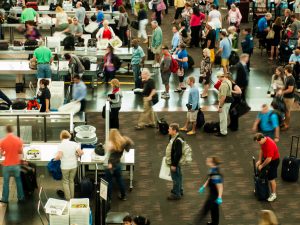TSA added 11 new names to the list of airlines that participate in the Pre-check program. Aruba, Avianca, Boutique, Emirates, Key Lime, Miami Air, Southern, Express, Spirit, Sunwing, Virgin Atlantic, and Xtra will join the current group of Aeromexico, Air Canada, Alaska, Allegiant, American, Cape Air, Delta, Etihad, Frontier, Hawaiian, JetBlue, Lufthansa, OneJet, Seaborne, Southwest, Sun Country, United, Virgin America, and WestJet. Pre-check is now available at more than 180 U.S. airports.
Pre-check can make airport security much less of a hassle, because it means you can:
- Go through a separate security lane at U.S. airports that, at least most of the time, is shorter than the general lane.
- Keep your shoes, belts, and light jackets on during screening.
- Keep your laptop/tablet and 3-1-1- liquids in your carry-on during screening.
TSA says that, last December, 97 percent of Pre-check travelers got through security in five minute or less.
Many of you already know the basics: To join Pre-check, start with an application, followed by an in-person interview and background check, and, once approved, receive a known traveler number. Travelers age 12 or under accompanying an enrolled adult need not enroll; travelers 13 and over need to enroll individually. Once enrolled, post your number whenever you book a ticket; alternatively add it to the frequent flyer data base of any airline you fly and the airline will automatically add it to all tickets it issues for you. From then on, your boarding passes will show a Pre-check symbol. If you buy an air ticket through a third-party agency such as Expedia or Priceline, call the airline to make sure your known traveler number is in its data base. Pre-check works only through your airline: You can't just show up at the airport with your ID and expect to get in the Pre-check lanes.
RELATED: More than 1 Million Now Enrolled in TSA Precheck
Although these benefits make the program sound like a great deal, the question for many travelers is whether the benefits are worth the cost of $85 for five years, or $17 a year. Pre-check is a no-brainer for road warriors or jet-set leisure travelers. But if you fly only two or three times a year, you might want to think about it, especially when you travel as a family.
Fortunately, you may not have to pay that much. Several dozen credit cards—mostly high-end cards—cover or offset the cost of enrollment. Just put the $85 fee on one of those cards. Check with the cardholder benefits listing of any cards you have to see which, if any, qualify.
If you travel internationally, also consider joining Global Entry, a, program that eases your way through arrivals at U.S. airports from international destinations. It automatically gives you a known traveler number, so it incorporates Pre-check. Global Entry enrollment works in about the same way as Pre-check, but costs $100 for five years and operates fewer enrollment centers. As with Pre-check, you credit card may cover or offset the enrollment cost. You can also qualify by enrolling in Nexus, a trusted-traveler program for Canada-U.S. travel, or Sentri, for Mexico-U.S. border crossings by land. Although I haven't seen any reports, you might be able to game the Pre-check enrollment fee by enrolling in Nexus, for $50, rather than paying the usual $85.
Check here for more information on Pre-check and to locate enrollment centers; check here for further information and enrollment in Global Entry, Nexus, and Sentri.
More from SmarterTravel:
- TSA Opens PreCheck to All U.S. Citizens
- Global Entry vs TSA PreCheck: Which Is Better?
- TSA Warns Travelers: New ID Requirements Coming in 2018
Consumer advocate Ed Perkins has been writing about travel for more than three decades. The founding editor of the Consumer Reports Travel Letter, he continues to inform travelers and fight consumer abuses every day at SmarterTravel.






